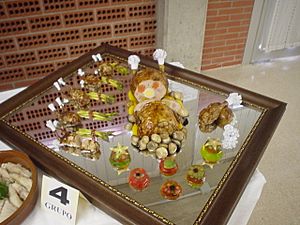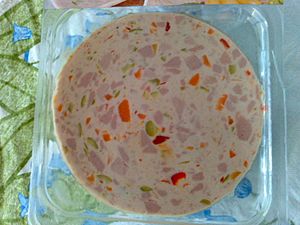Galantine facts for kids
Galantine is a special dish from French cuisine. It's usually made from meat, often poultry like chicken or duck, or even fish. The bones are carefully removed, and the meat is stuffed with a tasty filling called forcemeat.
After being stuffed, galantine is often shaped like a tube. It's then gently cooked in liquid, a method called poaching. It's always served cold, and sometimes it's covered with a clear, jelly-like coating called aspic. Making galantine can be a bit tricky because removing bones takes skill. It's often decorated beautifully, which is why its name means something "elegant" or "sophisticated."
Contents
What is Galantine?
Galantine is a fancy dish that looks great on a table. It's a type of charcuterie, which means prepared meat products. The meat is carefully deboned, then filled with a mixture of ground meat, spices, and other ingredients. This filling is called forcemeat.
How Galantine is Made
First, the bones are taken out of the meat, like a chicken or duck. This makes the meat flat. Then, a flavorful forcemeat is spread inside. The meat is then rolled up tightly into a log shape. It's cooked slowly in broth or water until it's done. After cooking, it's chilled until it's firm. Sometimes, a clear jelly made from meat broth, called aspic, is poured over it. This adds shine and flavor.
History of Galantine
The idea of galantine has a long history. It was known as a special dish in France. Some people say the technique was created by a chef for a French nobleman, the marquis de Brancas. This shows it was a dish for important people.
Galantine in the Middle Ages
Long ago, in the Middle Ages, the word "galauntine" or "galantyne" meant something different. It was a type of sauce. This sauce was often made from a spice called galangal root. It also included bread crumbs and other spices like cinnamon. The sauce could be cooked or uncooked. People used this sauce with fish, eels, geese, and even venison (deer meat). It was a popular way to add flavor to many dishes.
Galantine During Difficult Times
Galantine has even played a role in history during tough times. During the Siege of Leningrad in 1941–1942, a city in Russia was surrounded. People were starving. To help feed them, the authorities made galantine from unusual meat parts found in the seaport. This helped many people survive during a very hard period.
See also
 In Spanish: Galantina para niños
In Spanish: Galantina para niños



